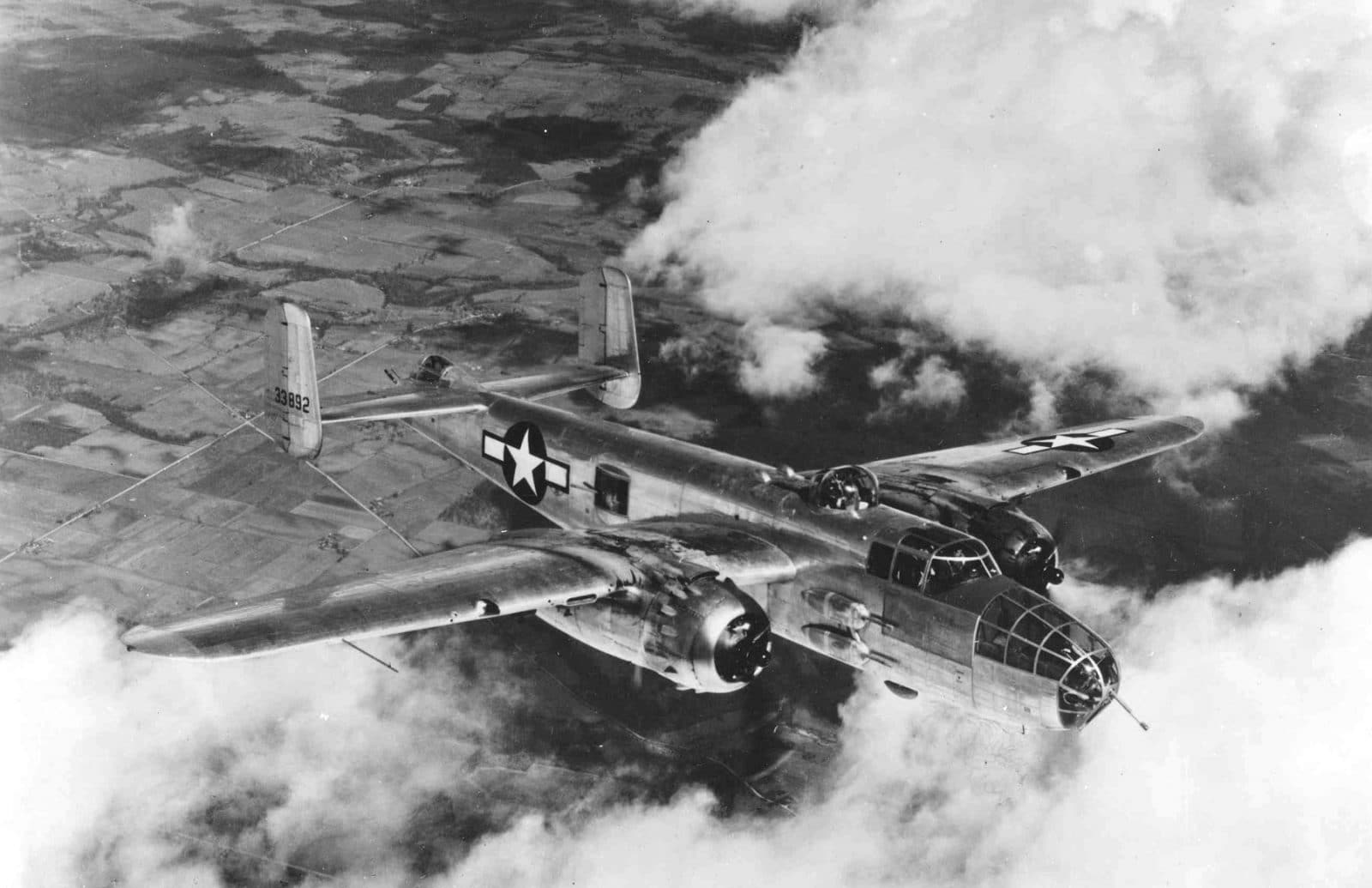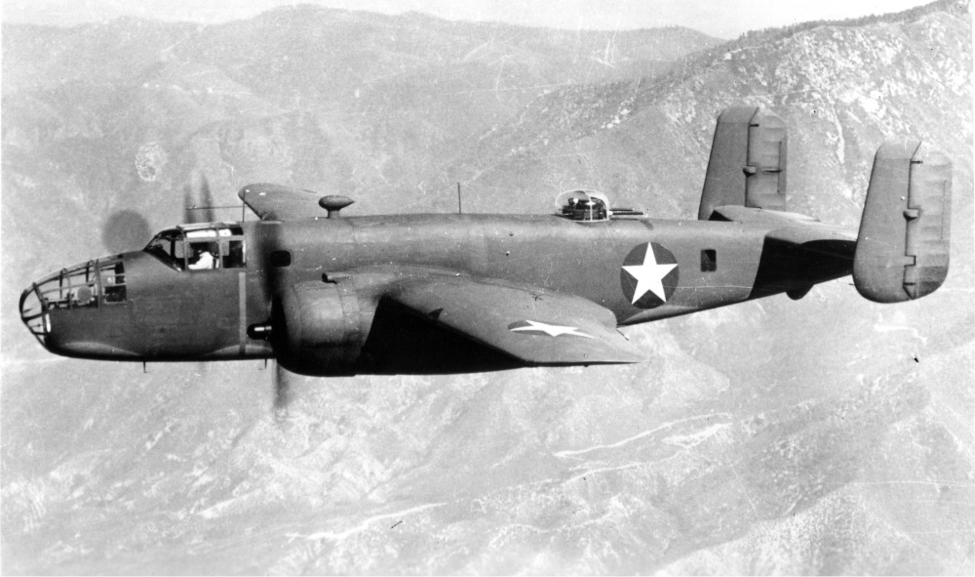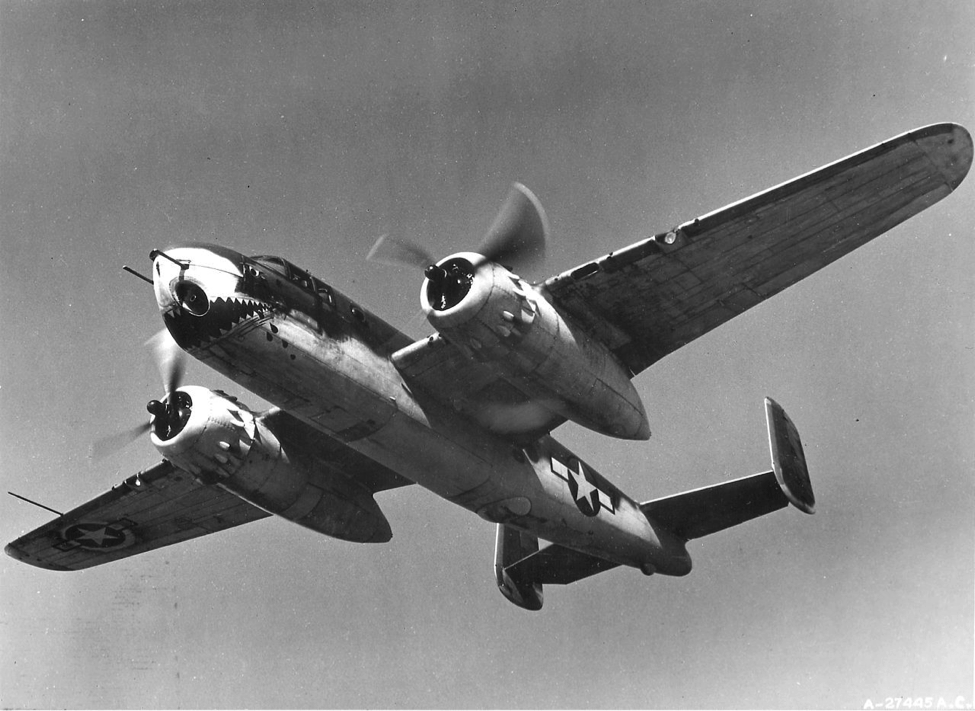The Ultimate Mitchell
The ultimate Mitchell, the B-25J, looked like the previous straight bomber variants up front but incorporated the H model crew stations aft. B-25Js all carried four 50 caliber machine guns installed on the fuselage under the cockpit in “package” mounts.
Built in larger numbers than any other B-25 variant, 4,318 J model B-25s rolled off the NAA production lines. NAA also produced a kit that added eight nose-mounted 50 caliber machine guns for a total of 14 that could be fired toward soon-to-be shredded targets.
Add the ability to fire HVARs and drop bombs, and the B-25J was capable of dishing out terrific amounts of punishment. B-25s equipped with cameras for aerial reconnaissance were designated F-10s.

Peanut Butter and Jelly
Navy and Marine Corps PBJs were in most respects identical to their USAAC counterparts. A significant difference was the increased use of radar in the PBJs. PBJ radars were usually mounted in place of the ventral turret or in a fairing protruding from the nose of the aircraft.
Later PBJs mounted the radar in a starboard wing fairing. Most PBJs equipped USMC bombing squadrons beginning in early 1943 with Marine Bombing Squadron 413 (VMB-413). The Marines operated their PBJs from the Philippines, Saipan, Iwo Jima, and Okinawa. Tasked primarily with long-range interdiction of Japanese shipping, the weapons of choice for the Marine PBJs were the 5-inch HVAR and the .50 caliber machine guns, both used effectively to enforce the virtual blockade of Japan.
In November 1944, the Navy put a B-25 on a carrier again, but this time, it was a PBJ-1H with a ginormous tail hook. The carrier was the USS Shangri-La (CV-38). The irony is that the last time B-25s operated from an aircraft carrier (the Doolittle Raid in 1942), when asked where the raid had originated, President Roosevelt replied, “Shangri-La.”
The PBJ-1H’s carrier suitability tests were judged to be marginally successful, but the project was not pursued beyond the feasibility study.
What? No B-25s in the ETO?
Surprisingly, no B-25s were assigned to squadrons in the European Theater of Operations (ETO). In the Mediterranean Theater of Operations (MTO), several squadrons equipped with B-25s began operations from Egypt during October 1942.
They targeted everything Axis in North Africa, flying missions there until the war, and their missions, shifted north to Sicily and Italy. These Mitchells performed effective “sea sweep” missions in the Aegean Sea and the approaches to Corsica, Sicily, and Italy.
Italian-based B-25s attacked targets in Italy, Austria, the Balkans, and anywhere else quick-reaction missions were needed. At maximum strength, there were 20 Bombardment Squadrons attached to 5 Bombardment Groups serving in the Ninth and Twelfth Air Forces in the MTO.
Tragedy in Gotham
At 0940 on Saturday, 28 July 1945, A USAAF B-25D Mitchell bomber, flying a routine personnel transfer mission bound for Newark airport in thick fog, crashed into the north side of New York’s Empire State Building between the 79th and 80th floors.
One of the Wright R-2600 engines from the bomber was found on a rooftop on the next block, where it had started a fire. Eleven people in the building were killed, along with all three of those aboard the aircraft.
An elevator attendant survived when the elevator she was in fell 750 feet to the building’s basement. The fire caused by the crash was the only one ever brought under control that high in a building or structure.

Pilot’s Report
B-25 pilots reported (and still do) that the aircraft was docile, forgiving, and safe to fly. Tricycle landing gear provided excellent visibility while taxiing and on approach. Large control surfaces made the airplane responsive, but it was a touch heavy on the controls.
The Wright R-2600 engines were good for about 3400 horsepower between them, which was more than adequate for the Mitchell. Control of the aircraft could be maintained, even banking turns into the nonfunctional engine of up to 60 degrees, down to 145 miles per hour. However, the rudder had to be used to control the direction of the B-25, as using ailerons could potentially cause loss of control.




A guy named Joe
Always (based on A Guy Named Joe)
My first flight as a young airman two striper was in a B-25 “hack” in 1956 from Griffiss to Stewart in New York. I sat on a bench just behind the pilots and directly in line with the propeller tips just inches beyond the skin of the ship. It was a very loud hour long trip. Pretty cool, though.
The SF B-movie “THEM!”
The doctors from Washington arrive in a B25
In the B Movie, The Claw”, the generals who were in command of the military response to a large alien bird terrorizing air and ground transportation, used a stripped-down B-25 with a cannon mounted in the tail to shoot “atomic fireballs” at the bird’s protective shield as it tried to catch the plane. Then, it used wing mounted rockets to kill it.
A B-25 was part of the story in No Time for Sergeants. The aircraft was being flown by Will Hutchins (later Sugarfoot) and Jamie Farr (MASH) with Nick Adams (The Rebel) and Andy Griffith as crew. I encountered Mr. Farr once as we waited to depart Little Rock Regional Airport, and I remarked about his appearance in this film. He said, “wow, that was before I was in the army”. He probably expected that I would ask about his part in MASH.
I lost interest reading this when the author describes the B-25 “Gull Wing” as having an anhedral angle. This is incorrect. The outer wing panels are mounted at zero degrees dihedral/anhedral. Because the inner wing panels are mounted with a dihedral the appearance is of a “gull wing” but it is strictly appearance. FWIW, the first 10 B-25’s, including “Miss Hap” which still flies, were constructed with a consistent dihedral from root to tip but later modified with the outer wing at a zero angle when shown to improve stability and handling.
A B-25 also appeared in “633 Squadron”.
I didn’t think it was possible to auger in and walk away with serious injury
My Uncle who was an Air Force pilot in WWII told me one of his experiences was ferrying B25’s to Fairbanks Alaska where they were then turned over to the Russians who wanted them for tank busters against the Germans. He was career Air Force and finished in the NSA.
How about 1992’s Forever Young, Mel Gibson is a B-25 pilot.
My dad flew B-25’s in the S Pacific in WWII. He had a engine blown off the mounts over Rabaul. They had no hydraulics or radios and flew back to Sterling Island and made a single engine gear up flaps up landing on the Japanese dirt strip. He was the only one injured as his L ear drum was ruptured when the Pom Pom shell hit the L Engine. Dad was loosing altitude and had the CE and a gunner opened the bomb doors with a crank, loosened the shackles an kicked loose the 4, 250 pound bombs with VT fuses set at 50 feet. 1LT Scruggs was awarded the Distinguished Flying Cross.